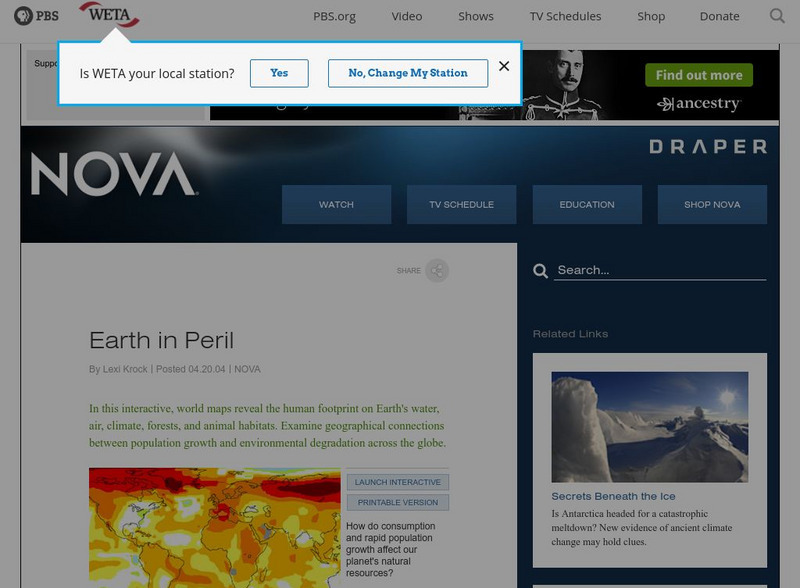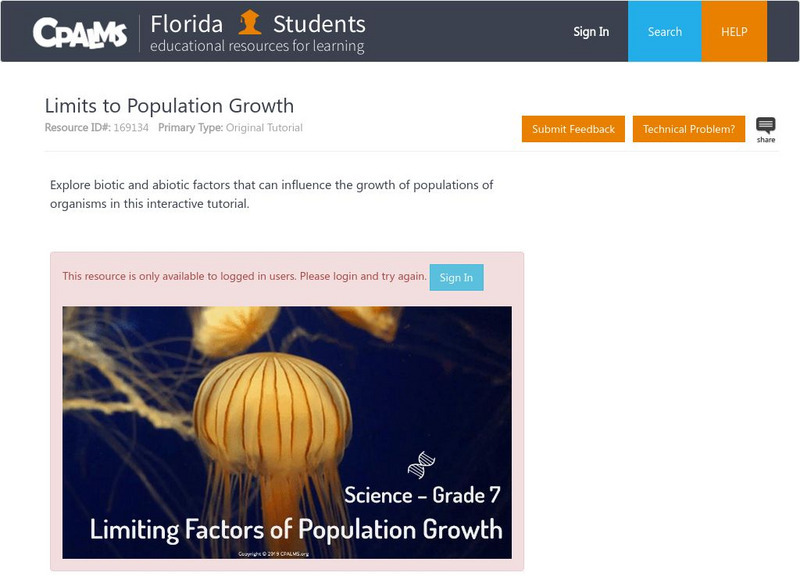Other
My Science Box: Ecosystem Organization
In this lesson, students will learn about the different levels in the hierarchy of ecology and explain the relationships: organism, population, community, ecosystem, biome, and biosphere. They will also discover why different regions...
Population Connection
Population Connection: Population and Environment[pdf]
A paper from the Population Connection that outlines the consequences to the environment if humans continue on the path of overpopulation.
SMART Technologies
Smart: Energy Flow in an Ecosystem
Students learn about Abiotic and Biotic Factors and how they affect the ecosystem in which an animal might live in.
National Geographic
National Geographic: Symbiotic Relationships in Marine Ecosystems
In this lesson students analyze videos to make observations about species, populations, and communities of organisms and discuss their symbiotic relationships. Then they create a hypothetical marine ecosystem and describe the adaptive,...
Concord Consortium
Concord Consortium: Dam Building: How Changes in Environment Affect Population
In this simulation, students build a dam in the middle of a field, dividing an ecosystem in half to illustrate the effects of environmental changes. They watch and collect data as the grass and then the rabbit populations in that region...
PBS
Pbs Learning Media: How Disruptions Affect Animal Populations
Students explore the effects that ecosystem disruptions can have on animal populations. They learn about the disruptions that have driven three species-the Madagascar fish eagle, the Iberian lynx, and the rowi kiwi, to the brink of...
National Geographic
National Geographic: Oil and Bird Populations
After learning about the diversity of wildlife in the Gulf of Mexico, students focus on birds and their patterns of behavior. They then how an oil spill might affect migrating birds, and possible ways to help them in the event of an oil...
Concord Consortium
Concord Consortium: Stem Resources: The Virtual Ecosystem
What does competition for food do to a population? Experience what happens to a rabbit population with limited resources in this virtual ecosystem. At the end of the exercise, there are questions relating to concepts reviewed.
Science Struck
Science Struck: Limiting Factors in the Desert Ecosystem
Describes conditions in a desert that limit how large populations of species can grow.
CK-12 Foundation
Ck 12: Life Science: 12.3 Population
Discover what a population is in regards to an ecosystem.
Oswego City School District
Regents Prep: Ecosystems/communities
Abiotic factors vary in the environment and determining the types and numbers of organisms that exist in that environment. Factors which determine the types and numbers of organisms of a species in an ecosystem are called limiting...
Science Struck
Science Struck: The 6 Chief Levels of Organization in Ecology
Describes six levels of organization in the biological world - individual species, population, community, ecosystem, biome, and biosphere.
PBS
Nova: Earth in Peril
A series of nine maps with accompanying explanations. They show how population growth has affected the environment around the world in terms of water availability, climate change, land and forest use, and more. There are both interactive...
CPALMS
Florida State University Cpalms: Florida Students: Limits to Population Growth
Explore biotic and abiotic factors that can influence the growth of populations of organisms in this interactive tutorial.
Concord Consortium
Concord Consortium: Evolution: Natural Selection
The concept of interdependence in an ecosystem and its effect on the evolution of populations is further explored through a model of a dam. Students build a dam in the middle of the field, dividing the ecosystem in half to illustrate the...
Other
Western North Carolina Vitality Index: Ecosystem Threats
The forests of Western North Carolina are threatened by a wide variety of environmental stressors and disturbances, such as insects, disease, invasive species, drought, fire, hurricanes, tornadoes, and ice storms. A stressor is any kind...
University of California
University of California Berkeley: Ecosystem Equilibrium
A simulator reviewing over the concepts of ecosystem equilibrium.
Science Education Resource Center at Carleton College
Serc: Environmental Interactions: Connectedness of a Natural System
A field experience where students undergo an exploration in a natural environment. They are introduced to the concepts of species, population, community, ecosystem, niche, and biosphere.
CK-12 Foundation
Ck 12: Life Science: 12.7 Competition
Understand how competition affects the populations in an ecosystem.
Utah STEM Foundation
Utah Stem Action Center: Great Salt Lake Ecosystem
This lesson plan provides an eight-day flow of educational activities in which students use the Great Salt Lake ecosystem to explore food webs and how changes in living and nonliving factors affect different populations.
CK-12 Foundation
Ck 12: Life Science: 12.4 Population Growth Patterns
Explore growth patterns in wildlife populations.
American Geosciences Institute
American Geosciences Institute: Earth Science Week: Monitoring Life in the Rocky Intertidal Ecosystem
This activity will allow students to learn the sampling techniques used in the field by citizen scientists who participate in LiMPETS, five national marine sanctuaries along the West Coast.
Read Works
Read Works: Changes in Biodiversity
[Free Registration/Login Required] An informational text about changes in biodiversity and the chain reaction of problems they can cause. A question sheet is available to help students build skills in reading comprehension.
Other
Pde Sas: Relationships Among Organisms
In this lesson, students compare various types of relationships among organisms (i.e., biotic interactions). Students will: explain the roles of producers and consumers, and predators and prey in an ecosystem. Explain the levels of order...
















